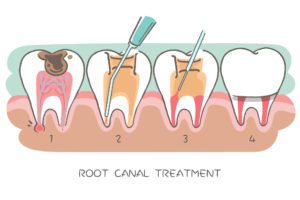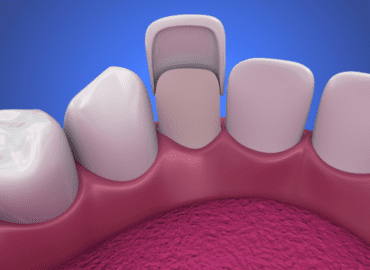Nobody particularly enjoys getting a dental procedure. Even though they can be scary, they can be necessary and shouldn’t be put off for too long. The more you know, the less intimidating it will be for you. If you think you may need a root canal, keep reading to learn about what exactly happens during the procedure.
During a root canal treatment, your dentist treats an infection formed in the pulp of your tooth. The infection will cause pain, but the treatment is painless. The root canal is supposed to resolve any discomfort you experience due to the infection.

What Causes a Tooth Infection?
A severely decayed tooth is the main reason you might need a root canal procedure. This is why it’s important to get cavities treated early. If a cavity gets too large, it enters your nerve and can cause pain or an infection.
If your tooth breaks or cracks, you might also need a root canal treatment. Any form of trauma to the tooth can expose your pulp chamber and damage your nerve. This will cause pain, and if left untreated, will lead to an infection.
4 Top Reasons Root Canals are Needed
You should visit a dentist immediately if you have any sort of tooth pain. You can never be too certain about how serious the issue is. It could be something minor that could go away on its own, or it could be something that requires dental treatment.
Knowing all the signs and symptoms of an infected tooth is important so that you can get it treated right away. If you notice the following symptoms, you might need to call your dentist and talk about setting up an appointment for a root canal procedure.
1. Severe Tooth Pain
An infected tooth will cause pain and sensitivity that will require a root canal. Sometimes, the pain could instantly hit you out of nowhere, or your tooth could be extra sensitive when you’re drinking a hot or cold beverage. Putting pressure on the side of your face where the aching tooth is could also cause some discomfort.
2. Tooth Discoloration
If you have an infection in the pulp of your tooth, it could lead to some discoloration. Any kind of injury or decay to your tooth can damage the roots and stop providing blood to the tooth. As a result, it will begin to die and turn a dark grayish color. Don’t wait too long to get a discolored tooth treated! Otherwise, you might end up having to get it extracted due to the severity of the damage.
3. Sensitive Gums
Sometimes, the gums around your affected tooth can become swollen and tender. This is from the dead pulp tissues that have built up over time. This could be a sign that you need a root canal.
You could also develop something called a dental abscess, which is a collection of pus that has formed around a tooth from a bacterial infection. This can be seen on an x-ray as a dark spot. That spot is a hole formed in your jawbone due to an infection preventing the bone from growing.
4. Cracked or Chipped Tooth
An accident that caused a crack or chip in your tooth could lead to inflammation or an infection. This is because the opening gives bacteria a place in your tooth to set. Other things that can result in a cracked or chipped tooth include chewing on hard food or grinding your teeth. A cracked tooth that doesn’t extend further than the enamel might not require treatment. If a crack does extend beyond the enamel, you’ll want to get it treated right away.
How Long Does a Root Canal Procedure Take?
The average root canal procedure takes between 30 minutes to an hour, with complex cases taking as long as 90 minutes.
Explore the root canal treatment steps below to understand the procedure better.
Root Canal Treatment Process (4 Key Steps)
A root canal treatment should be painless. During this process, your dentist numbs you, removes the infection in your tooth, cleans it, then seals it with a temporary filling.
It sounds like an intimidating process, but we promise it shouldn’t hurt! You’ll be happy you got it done once you don’t have to suffer from that toothache anymore. Here’s a step-by-step guide on what you can expect during your root canal procedure.
1. Anesthesia
You will need to be given anesthesia during a root canal procedure. After placing some numbing medicine on the gum near the affected tooth, your dentist will inject it with anesthesia. This will numb the entire area surrounding your tooth so you don’t feel any pain during the procedure.
A lot of people wonder, “Are you awake during a root canal procedure?” Yes, you will still be awake during the entire root canal treatment but won’t feel the procedure happening thanks to the local anesthesia.
2. Pulp Removal
Once the anesthesia takes effect, your dentist will make a small opening at the top of your tooth to access the pulp chamber. They’ll carefully remove the infected pulp and thoroughly disinfect the inside of the tooth.
3. Antibiotic Medication
After the infected pulp is removed, your dentist will coat the area with topical antibiotics if needed. This medicine will ensure that the infection is completely killed and prevent reinfection. You may also be prescribed oral antibiotics.
4. Temporary Filling
Finally, your dentist will fill the small opening with a temporary sealant. This will prevent saliva from entering the canal and damaging it. You may need a dental crown after your root canal treatment. Though it’s not required, it’s highly recommended because a crown will protect your tooth from breaking if it gets too brittle. Adding the dental crown will require another appointment.
Aftercare: What to Expect After a Root Canal Procedure
You will still feel numb for a few hours after your procedure, so it’s important to be mindful of what you eat immediately afterward. Once the anesthesia wears off, you should feel some pain or discomfort. If it’s too much for you to handle, you should take your prescribed pain medication.
Can You Drive After a Root Canal?
Most root canal procedures are done with a local anesthetic to numb the tooth, therefore you should be able to drive home or to work safely after the treatment. However, if you receive sedation medication or general anesthesia, you should get a ride home after the procedure.
Over the next few days, try to eat softer foods and chew on the opposite side of your mouth where you got the root canal treatment. Brush your teeth gently, and keep taking your antibiotics (if you were prescribed any) or pain medication if needed. Don’t forget to follow up with your dentist, even after you don’t feel pain anymore. It’s better to be safe than sorry!
What Happens If You Don’t Take Antibiotics After a Root Canal?
You may or may not receive oral antibiotics after a root canal procedure since they are not absolutely necessary. Generally, you need very little time to recover from a root canal. However, your dentist may prescribe oral antibiotics after root canal procedure on occasion and depending on your specific circumstances. You should consult with your dentist about whether antibiotics are necessary for you at the time of treatment.
Where to get a Root Canal in South Florida
If your aching tooth is starting to become a concern, maybe it’s time to schedule an appointment with Shapiro Family Dentistry in South Florida. We have four locations across South Florida including West Palm Beach, Boca Raton, Fort Pierce, and Boynton Beach. When there’s pain, there could be an infection that requires treatment. Give us a call today or request an appointment and ask us about our root canal procedure!
Shapiro Family Dentistry & Invisalign
Request an Appointment




























WE OFFER
COMPLIMENTARY SECOND OPINIONS
No Insurance? You Have Options!





